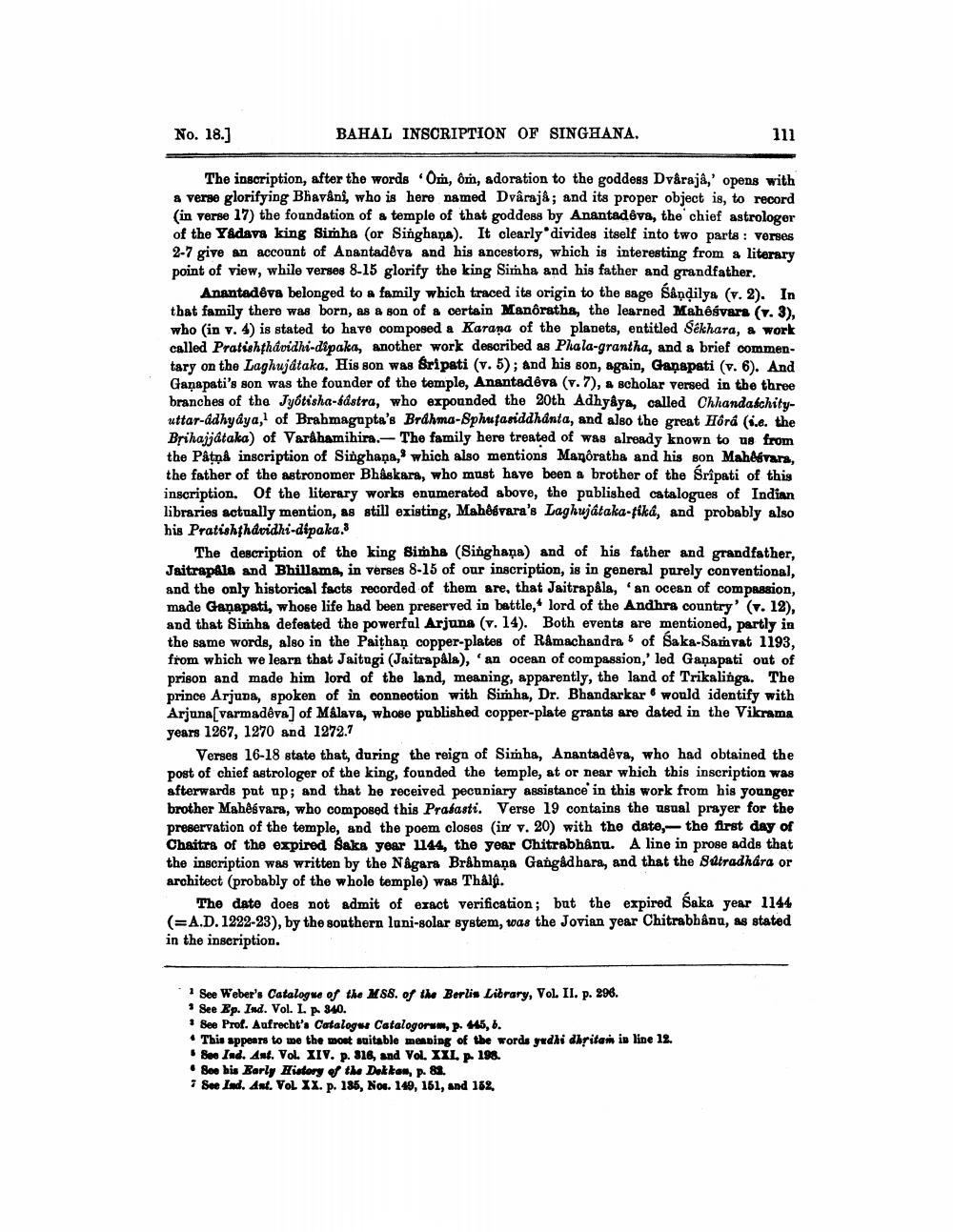________________
No. 18.]
BAHAL INSCRIPTION OF SINGHANA.
111
The inscription, after the words Om, ôm, adoration to the goddess Dvåraja,' opens with a verse glorifying Bhavani, who is here named Dvârajå; and its proper object is, to record (in verse 17) the foundation of a temple of that goddess by Anantadeva, the chief astrologer of the Y&dava king Simhe (or Singhana). It clearly divides itself into two parts: verses 2-7 give an account of Anantadêya and his ancestors, which is interesting from a literary point of view, while verses 8-15 glorify the king Simha and his father and grandfather.
Anantadêva belonged to a family which traced its origin to the sage Såndilya (v. 2). In that family there was born, as a son of a certain Manôraths, the learned Mahêsvars (v. 3), who (in v. 4) is stated to have composed a Karana of the planets, entitled Sekhara, & work called Pratishthavidhi-dipaka, another work described as Phala-grantha, and a brief commentary on the Laghujataka. His son was Sripati (v. 5); and his son, again, Ganapati (v. 6). And Ganapati's son was the founder of the temple, Anantadêva (v.7), a scholar versed in the three branches of the Jyotisha-fdstra, who expounded the 20th Adhyâya, called Chhanda&chityuttar-adhyâya,of Brahmagupta's Brdhma-Sphufasiddhanta, and also the great Hóra (i.e. the Brihajjátaka) of Varahamihira.- The family here treated of was already known to us from the Pâtņå inscription of Singhaņa, which also mentions Maqôratha and his son Mahdávara, the father of the astronomer Bhaskara, who must have been a brother of the Sripati of this inscription. Of the literary works enumerated above, the published catalogues of Indian libraries actually mention, as still existing, Mahéévara's Laghujátaka-fiká, and probably also his Pratishthavidhi-dipaka.
The description of the king Simha (Singhaņa) and of his father and grandfather, Jaitrapala and Bhillama, in verses 8-15 of our inscription, is in general purely conventional, and the only historical facts recorded of them are, that Jaitrapåla, 'an ocean of compassion, made Ganapati, whose life had been preserved in battle, lord of the Andhra country' (v. 12), and that Simha defeated the powerful Arjuna (v. 14). Both events are mentioned, partly in the same words, also in the Paithan copper-plates of Ramachandra 5 of Saka-Samvat 1193, from which we learn that Jaitugi (Jaitrapåla), ' an ocean of compassion,' led Ganapati out of prison and made him lord of the land, meaning, apparently, the land of Trikalinga. The prince Arjuna, spoken of in connection with Simha, Dr. Bhandarkar would identify with Arjuna varmadêva] of Malave, whose published copper-plate grants are dated in the Vikrama years 1267, 1270 and 1272.7
Verses 16-18 state that, during the reign of Simha, Anantadêva, who had obtained the post of chief astrologer of the king, founded the temple, at or near which this inscription was afterwards pat up; and that he received pecuniary assistance in this work from his younger brother Mahesvara, who composed this Prasasti. Verse 19 contains the usual prayer for the preservation of the temple, and the poem closes (ir v. 20) with the date, the first day of Chaitra of the expired Saka year 1144, the year Chitrabhånu. A line in prose adds that the inscription was written by the Nagara Brahmana Gangadhara, and that the Sutradhára or architect (probably of the whole temple) was Thalg.
The date does not admit of exact verification, but the expired Saka year 1144 (=A.D. 1222-23), by the southern luni-solar system, was the Jovian year Chitrabhånu, as stated in the inscription.
* See Weber's Catalogue of the M88. of the Berlin Library, Vol. II. p. 296. * See Ep. Ind. Vol. I. p. 840. • See Prof. Aufrecht's Catalogwe Catalogorwm, p. 445, 6. • This appears to me the most suitable meaning of the words yudhi dhrita in line 12 . See Ind. Ant. Vol. XIV. p. 316, and Vol. XXI. p. 198. . See his Early History of the Dekkes, p. 82. 7 See Ind. Ant. VoL IX. p. 185, Nou. 149, 161, and 152




